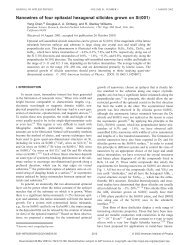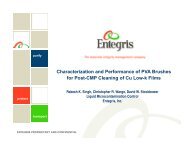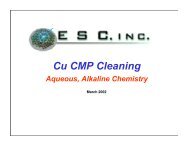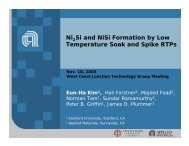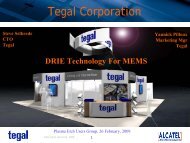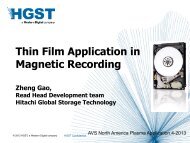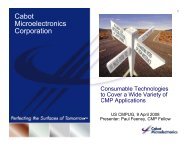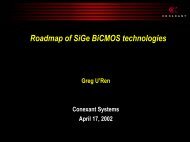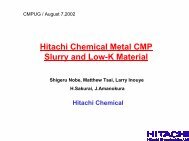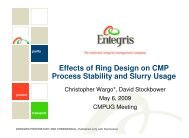A Study of Dilute Cu Alloys for Dual-Damascene Interconnect ...
A Study of Dilute Cu Alloys for Dual-Damascene Interconnect ...
A Study of Dilute Cu Alloys for Dual-Damascene Interconnect ...
- No tags were found...
You also want an ePaper? Increase the reach of your titles
YUMPU automatically turns print PDFs into web optimized ePapers that Google loves.
A <strong>Study</strong> <strong>of</strong> <strong>Dilute</strong> <strong>Cu</strong> <strong>Alloys</strong><strong>for</strong> <strong>Dual</strong>-<strong>Damascene</strong> <strong>Interconnect</strong> ApplicationsCara Hutchison, Anil Bhanap, Mike Pinter, Wuwen Yi,Karen Scholer, Nicole Truong, Bob Prater, Eal LeeHoneywell Electronic MaterialsNovember 19, 2003TFUG Meetingeal.lee@honeywell.com<strong>Cu</strong> Alloy Evaluation Page 1Proprietary and Confidential
AFM Microstructure <strong>of</strong> PVD <strong>Cu</strong>-Seed Film<strong>Cu</strong>-Ti (Ra=1.7 nm)<strong>Cu</strong>-Sn (Ra=1.01 nm)Grain size 86 nmGrain size 57 nmTi and Sn addition produced finer grain sizes.<strong>Cu</strong> Alloy Evaluation Page 5Proprietary and Confidential
AFM Microstructure <strong>of</strong> PVD <strong>Cu</strong>-Seed Film<strong>Cu</strong>-Ag (Ra=1.05 nm)Angled View <strong>of</strong> <strong>Cu</strong>-Ag30 nm15 nmGrain size 25 nmAg addition produced the finest grain sizes.<strong>Cu</strong> Alloy Evaluation Page 6Proprietary and Confidential
AFM topography <strong>of</strong> 1200A <strong>Cu</strong>-Al deposited @2 kW and 6kW at RT<strong>Cu</strong>Al @2kW/27A/s3DRa=2. 860 nm80 nm40 nm<strong>Cu</strong>Al @6kW/78A/s3DRa=0.646 nm20 nm10 nmHigh power deposition produces finer grain size and smoother surface due toenhanced nucleation rate.<strong>Cu</strong> Alloy Evaluation Page 7Proprietary and Confidential
XRD characterization <strong>of</strong> <strong>Cu</strong>-0.5at.%X filmsFilm(350C/30 min)XRD Integrated Peak Intensity (%) 6N <strong>Cu</strong>-Seed100 0 0 06N <strong>Cu</strong> + ECD85.1 4.8 3.1 6.9<strong>Cu</strong>Sn-Seed100 0 0 0<strong>Cu</strong>Sn + ECD82.2 8.2 4.0 5.6<strong>Cu</strong>Al-Seed100 0 0 0<strong>Cu</strong>Al + ECD64.8 18.0 7.3 10.0<strong>Cu</strong>Ag-Seed100 0 0 0<strong>Cu</strong>Ag + ECD56.0 21.9 10.2 11.9<strong>Cu</strong>Ti-Seed100 0 0 0<strong>Cu</strong>Ti + ECD80.7 6.8 3.5 9.0<strong>Cu</strong>-seed showed predominantly orientation <strong>for</strong> all alloying additions, but ECD <strong>Cu</strong>orientation varied with seed composition, 69<strong>Cu</strong> seed extending orientation most.<strong>Cu</strong> Alloy Evaluation Page 8Proprietary and Confidential
SIMS Analysis Layer StructureAnnealed @ 400 o C <strong>for</strong> 1 hour<strong>Cu</strong> 2kÅECD 5kÅ<strong>Cu</strong> 2kÅTaN/TaAlloy<strong>Cu</strong>AlloyBarrierOxide layer at this interfaceremains and may suppressthe diffusion. This can causenon-symmetric SIMS pr<strong>of</strong>ile.Oxide layer at this interfacedissolves away during ECD.<strong>Cu</strong> Alloy Evaluation Page 9Proprietary and Confidential
SIMS diffusion pr<strong>of</strong>ile <strong>of</strong> alloying elements after 400C/1 hr<strong>Cu</strong>-0.5 at.% Ag<strong>Cu</strong>10 8<strong>Cu</strong>-0.5 at.% Al10 8Concentration (atoms/cc)10 23 10 410 2210 2110 20Ag10 710 610 5Secondary Ion Intensity (cts/s)Concentration (atoms/cc)10 23 10 410 2210 2110 20Al<strong>Cu</strong>10 710 610 5Secondary Ion Intensity (cts/s)Concentration (atoms/cc)10 1910 2210 2110 200 0.1 0.2 0.3 0.4 0.5 0.6 0.7 0.8Depth (micron)10 8Sn<strong>Cu</strong>-0.5 at.% Sn<strong>Cu</strong>10 710 610 5Secondary Ion INtensity (cts/s)10 1910 1910 1810 170 0.1 0.2 0.3 0.4 0.5 0.6 0.7 0.8Depth (micron)10 8Ti<strong>Cu</strong>-0.5 at.% Ti<strong>Cu</strong>10 710 610 510 23 10 410 20 10 410 190 0.1 0.2 0.3 0.4 0.5 0.6 0.7 0.8Depth (micron)10 16Ag diffuses fastest followed by Sn.0 0.1 0.2 0.3 0.4 0.5 0.6 0.7 0.8Depth (micron)<strong>Cu</strong> Alloy Evaluation Page 10Proprietary and Confidential
Film Characterization Summary•Reflectivity <strong>of</strong> <strong>Cu</strong>-seed layer varies strongly with annealing temperature,whereas that <strong>of</strong> ECD <strong>Cu</strong> shows little variation.•Alloying addition imparts little effect on the grain size and electricalresistivity <strong>of</strong> ECD copper.•Stress <strong>of</strong> seed layer is generally higher than those <strong>of</strong> ECD <strong>Cu</strong>, but impartslittle effect on the stress <strong>of</strong> ECD film.•All alloyed <strong>Cu</strong>-seed films show good adhesion to TaN/Ta barrier.•All <strong>Cu</strong>-seed showed predominantly orientation regardless <strong>of</strong>composition.•SIMS analysis shows complete homogenization <strong>of</strong> Ag through ECD <strong>Cu</strong>,whereas Mg shows limited diffusion. Non-symmetric diffusion <strong>of</strong> Ti and AlSIMS indicates surface oxidation effect. Potential advantage ordisadvantage <strong>of</strong> this diffusional behavior should be evaluated.<strong>Cu</strong> Alloy Evaluation Page 11Proprietary and Confidential
Electrical Testing FlowProcess flowTest structureILD deposition: SiN\SiO 2Trench patterning:Litho, Etch, AshSnake•3Degas: 415C, 100 sBarrier dep.: TaN\Ta<strong>Cu</strong> seed dep.CombECP <strong>Cu</strong> (10kA)<strong>Cu</strong> Anneal200C/60minCMPE-TEST•1•Line-to-line leakage (also called comb leakage):Apply voltage between Pads (1,2 shorted) and Pad (3)•Snake resistance (also called Serpentine resistance):Apply voltage between Pad 1 and Pad 2•2<strong>Cu</strong> Alloy Evaluation Page 12Proprietary and Confidential
Comb Leakage <strong>Cu</strong>rrent and Serpentine ResistanceComb Leakage currentL/S = 0.32/0.32 µSerpentine resistance% Probability999590807060504030201051<strong>Cu</strong><strong>Cu</strong>Ag<strong>Cu</strong>Al<strong>Cu</strong>Sn<strong>Cu</strong>Ti%probability999590807060504030201051<strong>Cu</strong><strong>Cu</strong>Ag<strong>Cu</strong>Al<strong>Cu</strong>Sn<strong>Cu</strong>Ti-13-12-11-10log(A/mm)-9-8-7-6100200300Ohm/mm400500SiO2 (3500A)SiN (500A)Si Substrate•<strong>Cu</strong> alloy composition did not significantly affect comb leakage current•<strong>Cu</strong>-Ag and <strong>Cu</strong>-Al show 10-15% higher serpentine resistance than 69<strong>Cu</strong>•<strong>Cu</strong>-Ti and <strong>Cu</strong>-Sn show % higher serpentine resistance than 69<strong>Cu</strong><strong>Cu</strong> Alloy Evaluation Page 13Proprietary and Confidential
Resistance vs. Line Width <strong>for</strong> Copper <strong>Alloys</strong>600Median resistance (Ohm/mm)500400300200100<strong>Cu</strong><strong>Cu</strong>Ag<strong>Cu</strong>Al<strong>Cu</strong>Sn<strong>Cu</strong>Ti00.2 0.22 0.24 0.26 0.28 0.3 0.32 0.34 0.36 0.38 0.4Line Width (micron)Serpentine resistance in the 0.24 – 0.38 micron line width range:Line resistance decreases with line width because <strong>of</strong> reduced liner contributionAlloying Effect: 69<strong>Cu</strong> < <strong>Cu</strong>-Al ~ <strong>Cu</strong>-Ag < <strong>Cu</strong>-Ti ~ <strong>Cu</strong>-Sn<strong>Cu</strong> Alloy Evaluation Page 14Proprietary and Confidential
Water Box Corrosion TestProcess flowSi waferOxide ILD depositionM1 trench patterningDegas/Barrier/<strong>Cu</strong> Seed dep<strong>Cu</strong> platingAnneal: 200C, 1 hrM1 CMPOptical inspectionETEST<strong>Alloys</strong>69<strong>Cu</strong><strong>Cu</strong>-Al<strong>Cu</strong>-Ag<strong>Cu</strong>-Sn<strong>Cu</strong>-Ti<strong>Cu</strong>-MgAt serpentine-combstructures from 9 diesnear wafer centerOptical inspectionWater box exposureETESTStore in sealed wafer box with DIwater at bottom. Room Temp. 24 hr<strong>Cu</strong> Alloy Evaluation Page 15Proprietary and Confidential
Optical Inspection <strong>of</strong> 69<strong>Cu</strong>Corrosion<strong>Cu</strong> Alloy Evaluation Page 16Proprietary and Confidential
Optical Inspection <strong>of</strong> <strong>Cu</strong>-AgCorrosion<strong>Cu</strong> Alloy Evaluation Page 18Proprietary and Confidential
Optical Inspection <strong>of</strong> <strong>Cu</strong>-SnCorrosion<strong>Cu</strong> Alloy Evaluation Page 19Proprietary and Confidential
Optical Inspection <strong>of</strong> <strong>Cu</strong>-TiNo Corrosion<strong>Cu</strong> Alloy Evaluation Page 20Proprietary and Confidential
Optical Inspection <strong>of</strong> <strong>Cu</strong>-MgPr<strong>of</strong>use Corrosion<strong>Cu</strong> Alloy Evaluation Page 21Proprietary and Confidential
Summary <strong>of</strong> Optical Inspection•Significant corrosion was seen after water box test incase <strong>of</strong> seed layer <strong>for</strong>med by 69<strong>Cu</strong>, <strong>Cu</strong>-Ag, <strong>Cu</strong>-Sn, and<strong>Cu</strong>-Mg alloys•Very little corrosion was observed in case <strong>of</strong> <strong>Cu</strong>-Al,whereas <strong>Cu</strong>-Ti seed layer showed no corrosion.•Preferred corrosion sites are edges and corners <strong>of</strong> <strong>Cu</strong>features, especially those adjacent to large fieldregions.<strong>Cu</strong> Alloy Evaluation Page 22Proprietary and Confidential
Serpentine Resistance be<strong>for</strong>e and after exposure to water vaporL/S = 0.32/0.32 µmBe<strong>for</strong>e water-box exposureAfter water-box exposure9 99 58 07 06 05 04 03 02 01 05<strong>Cu</strong><strong>Cu</strong>Ag<strong>Cu</strong>Al<strong>Cu</strong>Sn<strong>Cu</strong>Ti9999959580 8070 7060506040504030 3020 2010 105 51110500001000000050000100000Water box exposure caused the highest increase in serpentineresistance <strong>for</strong> 69<strong>Cu</strong> and <strong>Cu</strong>-Ag, followed by <strong>Cu</strong>-Sn.No change in serpentine resistance was noticed in case <strong>of</strong> <strong>Cu</strong>-Al and<strong>Cu</strong>-Ti seed layers.<strong>Cu</strong> Alloy Evaluation Page 23Proprietary and Confidential
Summary <strong>of</strong> E-TestE• ECD <strong>Cu</strong> with 69<strong>Cu</strong> seed rendered the lowest line resistance andthe highest with <strong>Cu</strong>Ti seed.• Alloying elements imparted no significant impact on line leakagecurrent.• Excellent corrosion resistance was seen in single level metalstructures <strong>for</strong>med using <strong>Cu</strong>-Al and <strong>Cu</strong>-Ti alloys as seed layer.This is likely due to a possible <strong>for</strong>mation <strong>of</strong> a protective oxide filmon <strong>Cu</strong> surface (e.g., Al 2 O 3 , TiO 2 ).•While Ag and Sn diffuse easily throughout <strong>Cu</strong> during annealing,it doesn’t seem to <strong>for</strong>m a protective layer•<strong>Cu</strong>-Sn alloy needs to be studied further. While the opticalimages showed significant corrosion, the serpentine resistancewas affected less than in case <strong>of</strong> 69<strong>Cu</strong> and <strong>Cu</strong>-Ag.<strong>Cu</strong> Alloy Evaluation Page 24Proprietary and Confidential
Final Remarks•Ag is considered to be the best candidate <strong>for</strong> improvingelectromigration resistance in consideration <strong>of</strong> its fasthomogenization, low electrical resistivity, and highatomic mass. However, actual EM data is still needed.•Ti shows the best corrosion resistance but increaseselectrical resistivity in both seed and ECD <strong>Cu</strong>.•Al shows excellent corrosion resistance and producesnegligible increase in electrical resistivity <strong>for</strong> ECD <strong>Cu</strong>.•Sn is the highest atomic mass element tested andconsidered to be good <strong>for</strong> electromigration resistance.<strong>Cu</strong> Alloy Evaluation Page 25Proprietary and Confidential



